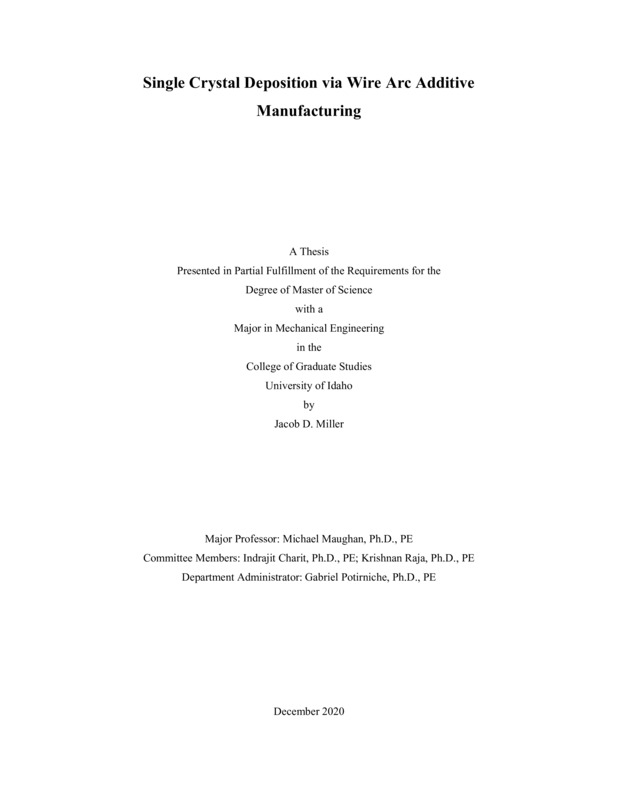Single Crystal Deposition via Wire Arc Additive Manufacturing
Miller, Jacob D.. (2020-12). Single Crystal Deposition via Wire Arc Additive Manufacturing. Theses and Dissertations Collection, University of Idaho Library Digital Collections. https://www.lib.uidaho.edu/digital/etd/items/miller_idaho_0089n_11956.html
- Title:
- Single Crystal Deposition via Wire Arc Additive Manufacturing
- Author:
- Miller, Jacob D.
- ORCID:
- 0000-0001-6232-5562
- Date:
- 2020-12
- Keywords:
- Single-Crystal WAAM
- Program:
- Mechanical Engineering
- Subject Category:
- Mechanical engineering; Materials Science
- Abstract:
-
The rapidly evolving field of additive manufacturing has developed from a niche manufacturing technique to a rapidly evolving manufacturing technique. The ability to manufacture complex geometries in addition to reduction in wasted materials common to subtractive manufacturing techniques has led to further inquiry not only in deposition methods but materials as well. One material that is currently manufactured at high expense are single crystal components.
Single crystal components are typically subjected to harsh environments including high thermal exposure and repeated stress. The boundary-free lattice structure of a single crystal is ideal in these situations due to its high resistance to creep and fatigue crack growth. Current methods of manufacturing these components involve highly controlled directional solidification, a time and material costly procedure. The objective of this study is to investigate the feasibility of additively manufacturing single crystal components via Wire Arc Additive Manufacturing (WAAM) and with a variation of the Tungsten Inert Gas (TIG) process. WAAM tests were conducted using the University of Idaho’s WAAM machine, VandalForge, as well with the TIG variant. Material was deposited first onto an ultra-pure zone refined single crystal ingot for feasibility validation and then onto a 99.995% pure single crystal substrate oriented in the <111> direction.
Once deposits were made onto the substrates, samples were cold mounted in epoxy, polished and etched using Marble’s reagent. Optical Microscopy (OM) provided distinct images of segregated grain boundaries, however samples were also mapped with EBSD to confirm the effectiveness of the etchant for pure nickel grain boundaries. Further analysis of both OM and EBSD yielded that single crystal regions of deposited material had formed on the substrate.
- Description:
- masters, M.S., Mechanical Engineering -- University of Idaho - College of Graduate Studies, 2020-12
- Major Professor:
- Maughan, Michael
- Committee:
- Charit, Indrajit; Raja, Krishnan
- Defense Date:
- 2020-12
- Identifier:
- Miller_idaho_0089N_11956
- Type:
- Text
- Format Original:
- Format:
- application/pdf
- Rights:
- In Copyright - Educational Use Permitted. For more information, please contact University of Idaho Library Special Collections and Archives Department at libspec@uidaho.edu.
- Standardized Rights:
- http://rightsstatements.org/vocab/InC-EDU/1.0/

